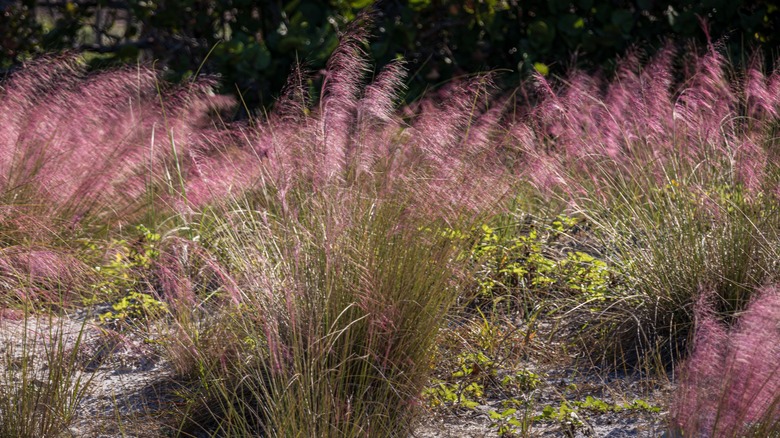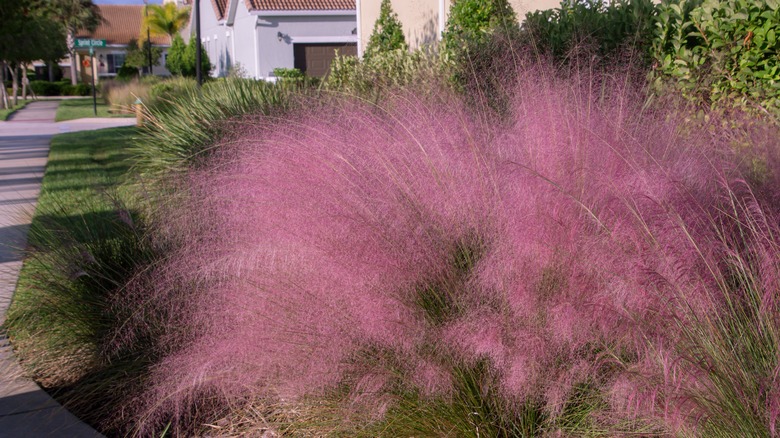Here's What You Should Know About Pink Muhly Grass' Color & Maintenance
If you're looking for an ornamental grass that will add flowing movement and attractive color to your landscape, pink muhly grass (Muhlenbergia capillaris), affectionately known as cotton candy grass, is a hot contender. Muhly grass is a perennial that's native to the middle and eastern United States and this unique pink variety is a gardeners' favorite because of its graceful pastel flower stalks. It's fast-growing and can be divided in early spring if the clumps of grass are big enough. If you want to add this ornamental grass to your lawn, you need create the conditions it favors for optimal growth and maintenance so that its color can enhance your garden year after year.
It's easy to see why this grass gets its nickname. Its beautiful feathery fronds can grow between 1 to 3 feet tall. In late summer through early fall, this plant's clusters of tiny flowers look like pink floating clouds, providing an eye-catching contrast to their dark green stems and leaves. Pink muhly grass prefers at least six hours of direct sunlight but will survive in a semi-shaded area. It is at home in dry, stony, and even sandy soil. Pink muhly grass will flourish in zones 6 to 9, it will need watering weekly until it is well established, and then it will be sustained by regular rain. It is drought tolerant and requires little maintenance, making it well worth the investment.
Bringing out the best in your muhly grass
Muhly grass is a perennial plant that will last for decades, but another reason why it's so popular is that it doesn't need babying. When you plant it, dig a hole that's about two to three times as wide as the root ball and slightly deeper as well. Leaving the top of the root ball just above the topsoil will allow it to settle comfortably into its hole in the surrounding loose soil and level itself out. After planting, give it a good soaking, then you can sit back and watch it flourish. If the plant is sluggish or its growth is looking a little stunted, a slow-release fertilizer applied during early winter should do the job. Otherwise, fertilization is not required.
Pink muhly grass can be cut back during the late winter or early spring. Don't go too heavy on the pruning. When cutting back your plant, leave 3 to 4 inches at the top of the clump so that it will have a good starting point during the growing season. As with any ornamental grass plant, pruning can be an awkward job. To make it easier and keep it tidy, bundle the grass stalks and tie with a piece of string before cutting.
How to make your muhly grass last
This delicate-looking delight is a deceptively hardy perennial, so you can enjoy its beauty year after year. The flowering stems will last between six to eight weeks, or a little less if you live in a zone that is prone to early frost. For the plant as a whole, you can expect each clump to produce new growth every year, increasing in size, so you can share it with your friends and neighbors.
If you want a popular ornamental grass like pink muhly grass to last even longer, you can dry it for use in your favorite flower arrangements. As you would when preparing any ornamental grass for drying, harvest the grass plumes in the early afternoon when the dew has dried and there has been no rain. Once any fluid has drained from the stems, gather them into small bundles and gently tie them with string or ribbon, being careful not to bend or damage the stems. Hang the bunches upside down in a dry, well-ventilated room. A dark or low-lit space will prevent them from fading. They should be completely dried out and ready to use within three weeks.


